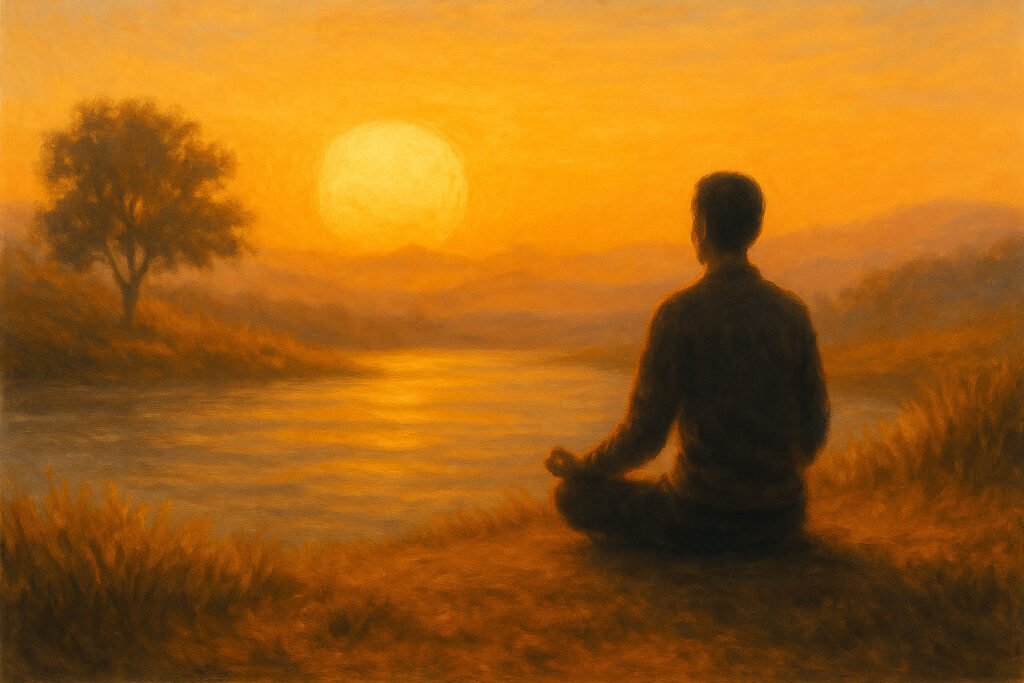
Breathing Your Way Back Home
A Buddhist parable of a blind turtle inspires reflection on life’s rarity, balancing samsara’s struggles with presence and spiritual homecoming.

Humans love data. We want to measure things. It’s in our DNA to seek knowledge and information that helps us explain our place in the universe. We have so many ways to get at the heart of this data, and now, with the advent of AI, it seems we have a limitless capacity to probe the depths of almost any aspect of life.
As a cultivator, I love soil science. I have to understand the soil composition in order to steer the plants effectively. When I study a soil report following a laboratory analysis, the details of the composition of that soil are revealed in black and white—in parts per million, grams per cubic centimeter, or pounds per acre. The health of the soil is revealed in the data; the numerical values provide a blueprint for how I need to create optimal balance.
The same is true for my own blood chemistry. A blood sample provided to a lab will generate a report with a complete breakdown of biomarkers revealing overall health through the data set—actionable insights through numerical assessments of lipid panels, thyroid function, vitamin D levels, and many other markers. It’s very black and white; clean numbers with clear outcomes.
If I want to assess the health of my business, the financial reports will spell it out. Run the PnL and balance sheet, and a clear picture emerges. We rely on this data in order to determine what adjustments are needed. Again, very concrete and clear, actionable items. These are the instruments for the data we seek in order to achieve the results we want.
But what about the mind—the seat of consciousness itself? I’m referring here to the mind, not the brain. The brain is the biological platform that gives rise to mental phenomena, whereas the mind is the field of awareness in which those phenomena unfold. The brain can be scanned, mapped, and measured. Psychiatrists and scientists rely on MRIs to reveal its structure and detect abnormalities—tumors, neurological disorders, the scars of stroke. But the mind is different. The mind is the subjective experience that arises from that biology—thought, emotion, imagination—and it remains beyond the reach of our instruments.
If we are looking for real data—like a soil report or a blood panel—about our cognitive health, we won’t find it. There is no report. The answer is clear: we are the instrument. We are the lab, the observer and the observed.
So what are tools and practices that can help us access and understand the mind and our consciousness? These are my top 5: meditation, psychotherapy, mindfulness, writing, and even psychedelics. Here’s my take on how they can provide insight even if they can’t produce a tidy report.
To begin, meditation has been used by humans for thousands of years as one of the sharpest tools in the shed for self-reflection. When we sit, we observe. When we observe, we gain insights. In that moment of quiet observation, our self-awareness is the best tool we have to tune into our mental state and understand the hidden layers of our consciousness. In a meditative state, we notice subtle and not so subtle thought patterns moving through our consciousness. We are forced to confront the moment of understanding “who” is looking out from behind our eyes. Of note, a recent study compared the effects of ten vs twenty minutes of daily meditation. The effect on anxiety, attention and mindfulness were essentially the same. Meaning just 10 minutes of meditation can have a measurable benefit.

When we combine meditation with psychotherapy—with an advanced practitioner—we have a mirror and a sounding board for those observable insights. This work takes the insights from solitary meditation and brings them to a more active dynamic. Sitting in a quiet room with a therapist who is trained in the art of connecting the dots and distilling insights into a coherent narrative is about as close as we get to holding a mirror to the psyche. This kind of human-to-human engagement in the pursuit of self-knowledge is where we find some of our clearest insights. The entire trajectory of my life was shifted forever because I was lucky enough to connect with a skilled therapist at a critical juncture of my development.
The philosopher and father of modern psychology, William James, believed that introspection was “the first and most immediate tool” to achieve deep understanding and insight for the psyche. “The greatest discovery of my generation is that human beings can alter their lives by altering their attitudes of mind.” It’s the only way we can truly see any real change.
In addition to meditation and psychotherapy, the daily practice of mindfulness is another modality we can explore. Mindfulness practice is actually quite simple, but it is extremely powerful. Jon Kabat-Zinn says, “Mindfulness means paying attention in a particular way: on purpose, in the present moment, and non-judgmentally.” It is essentially being aware of what’s happening as it happens—attention without judgment, awareness without commentary. The beauty of mindfulness practice is that it can be done anywhere, at any time. True presence brings consciousness into the moment—not to analyze the mind, but to experience life as it unfolds. In that fullness, awareness widens and we touch the subtle thread that links us to everything else.
And now if we want to bring those deeper insights of our consciousness into the light of day, writing or journaling is the go-to practice. The act of writing is using the page as a mirror. When we put our thoughts into words, the mind becomes visible to itself. Every word, every sentence, is a small act of awareness that slowly shapes our ability to see more deeply. The hidden architecture of our mind comes into view on the page. This is why writing is so powerful—it reactivates and reveals what’s been stored in our neural pathways, bringing the unseen patterns of thought and emotion into the black and white of the page.

And here with the fifth and final tool in our tool kit, some therapists are now looking at integrating psychedelic drugs such as psilocybin and MDMA as yet another tool to access deeper layers of consciousness. The word psychedelic, from Greek, literally means mind-manifesting. As a catalyst, these mind-expanding compounds can unlock portals of awareness that otherwise remain untapped. In the proper set and setting, they can have a profound effect on past traumas and deeply imprinted psychic patterns where we remain stuck for years. An experienced practitioner can guide a profound and life-altering journey into the patient’s consciousness that can move them into a level of awareness and insight that was previously inaccessible. Studies are emerging out of Johns Hopkins Center for Psychedelic and Consciousness Research are showing immense promise for the effects of psilocybin on depression, anxiety and addiction. Brain imaging shows that psilocybin decreases activity in the brain’s default mode network associated with the ego or “self-referential” thinking. This creates space for new patterns of connectivity and perception.
We don’t have a soil test for our consciousness. But we do have ways to access our inner world and understand ourselves more deeply. Attention and mindfulness become our probe. Presence is like a pH test. I think the key is is simply to make space for quiet, meditative work in order to tap in and see clearly. In today’s world of smartphones and screen distraction, the challenge has perhaps never been greater to access the depths of our consciousness amidst a sea of relentless distraction.
While science can measure the brain’s activity and hint at the psyche’s state—through scans, inventories, and biomarkers—it cannot offer the clear diagnostics we find in conventional instruments of analytics. Our awareness is the instrument, and the only true, meaningful insight comes from the practice along with an intention to simply be present. Instead of a printed report with black-and-white analysis, what we have is something we can feel which then shapes our way of seeing the world. It can be captured in a reflective journal piece and integrated into our practice; and this is where growth and insight occur. I continue to believe that my task is simply to show up for that appointment of introspection, ask the tough questions, and lean into the process of self-discovery.
If a balanced and happy life of meaning and purpose revolves around mental strength and equanimity, then on a slow ten count, reflect on your current practice of introspection. What is the current work? What is one element that could be added to a daily or weekly routine? How would that shift your level of self-awareness? How would it shape your consciousness and your presence? I hope this is just a nice reminder of elements and aspects of self-awareness that you already have locked into your rituals and routine. Have a great week!

A Buddhist parable of a blind turtle inspires reflection on life’s rarity, balancing samsara’s struggles with presence and spiritual homecoming.

Pablo Neruda’s “Keeping Quiet” teaches stillness amid chaos, reminding us that silence, breath, and presence restore peace and balance.

Inspired by Rory McIlroy’s Masters win and local golf struggles, this meditation explores resilience, nerves, and the courage to persevere.